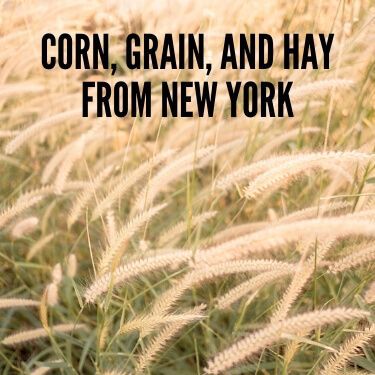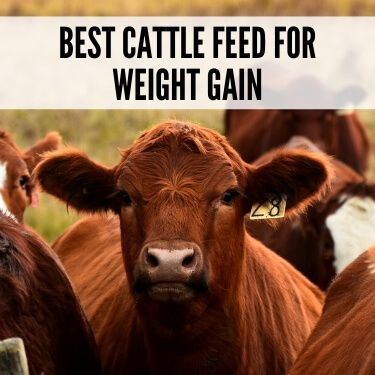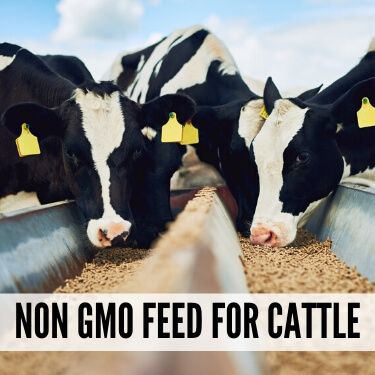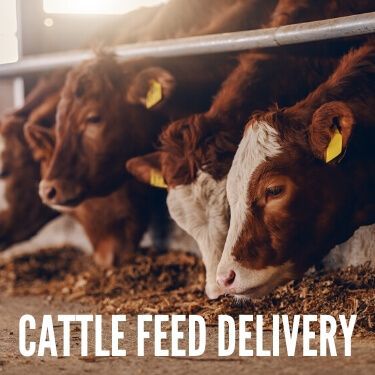Someone somewhere has a whole herd of cattle that need to be constantly fed. In fact, there are herds all over the United States with the same situation. If you’re a business that supplies animals with food, then shipping bulk cattle feed is probably a topic that moves you into action.
Shipping bulk cattle feed to customers doesn’t have to be a stressful occurrence but it is important to get it right. The feed could be easily damaged, or even if it’s bagged food, a rip in the packaging can lead to loss of product or call for a reduced price.
Let’s explore the different kinds of cattle feed — including those that come in bushels and bales out of New York — and how to get it to the people who need it. Hopefully, the following tips will help your business achieve its goals of shipping out bulk feed deliveries.
When people think about the state of New York, the first thing that comes to mind probably isn’t one of an agricultural powerhouse. However — in just corn, grain and hay alone — the northeastern state produces a little over $1.67 billion of those three crops across roughly 3.5 million acres in 2018.
The hay, for sure, is meant strictly as animal feed while the grain and corn is a mixture of human and animal consumption. Hay is worth $827 million to New York farmers and is crucial to cattle who don’t have access to pastures, are kept in barns and stables, or where the grass is too rich for their diet. It is also essential during the colder months when the grass either dies or is of a much lower nutritional quality.
Corn is a huge feed production crop for New York as well, averaging over $400 million per year in just corn silage alone. It is a top 20 producer of the crop in the United States and growers plant more than 1 million acres per year in the Empire State.

Feeding a cow is no small undertaking: on average, the large mammal can eat about 25 pounds of food per day and drink about 30 gallons of water over the same timeframe. During certain times, which will be described in more detail below, it can be even more.
Before deciding on the different types of cattle feed, you have to consider what kind of cows you’re feeding. No, not the breed, but if the cows in question are dairy or beef cattle.
These two have different diet requirements in order for them to serve their ultimate purpose.
The best feed for these cows includes roughage, grains, oilseeds and also some leftover human food to use as filler. The various combinations of these items into a cow’s nourishment is called feedstuffs.
Roughage is just like it is for humans, except instead of greens and other fibrous food, it is hay, grass and silage for cattle.
Silage is an important crop that is placed in a silo and is kept in a somewhat moist condition through a partial fermentation process. Farmers like using it for cattle because the process, which deprives the corn of oxygen and uses bacteria to effectively pickle the crop. Once it is in its fermented state, silage can be kept for a long time without losing quality.
The roughage is generally indigestible and insoluble and is the primary ingredient in cud. Cud chewing in ruminants — which includes cows, sheep, goats and deer — is the portion of the food that is regurgitated and needs to be rechewed a second time to fully digest it and make sure the animals get the most available nutrition from the food.
Also, using the highest quality forage will have a direct impact on your cattle’s appearance, performance and overall health. Roughage will make up the bulk of a cow’s diet.
Common grains fed to cattle include oats, barley and corn. These foods are high in energy for the cattle but have little fiber and are not very filling, so they don’t comprise a large part of the animal’s intake.
Oilseeds are crucial components of a cattle’s diet as these items, which are usually soybeans or canola meal, are both high in energy and high in protein.
The leftovers from human consumption, known as co-products, generally add very little actual nutrition and are mostly used as filler. Some corn products are especially sweet for cattle and should be limited in their use.
The 25 pounds of food per cattle per day is an average. To determine how much to feed your beef cattle, various factors must be taken into account, such as the animal’s:
They have similar dietary requirements as far as the type of feed they receive, but they generally need more food and more water to account for the demands that lactation puts on a cow’s body. For instance, in week 1 of a dairy cow’s second lactation, the animal needs about 35 pounds of food. By week 5 of the same lactation cycle, that should be increased to roughly 52 pounds.
Manipulating the way the cows intake their food can make the milk itself different. For instance, feeding the cattle its protein and carbohydrates together will result in milk with a higher fat content.
Furthermore, dairy cattle have a special minerals requirement to remain in good health and, in turn, achieve peak milk output. Calcium and phosphorus need to be added in moderate amounts to the feed, since these are minerals lost by the dairy cow during lactation.
There are various reasons why you’d want your cattle to gain weight. Perhaps it is a calf that needs fattening to reach its full growth potential. Or beef cattle that could use some more meat on their bones before hitting the market. Or a dairy cow who needs to gain weight back after a long period of lactation.
Regardless of the reason, the most efficient way to help cattle gain weight is to get the highest quality hay you can and add a percentage of protein to it. The hay will give the animals the energy they need and the protein will help the cattle by allowing the nutrition of the hay to be optimally absorbed and converted into more calories, therefore converting to more weight.
Another option is to use a weight gain supplement with the cattle’s normal intake of food. These can be in liquid or pellet form and be added as needed. They contain vitamins, minerals and oils that promote Omega-3 fatty acids, which also help promote weight gain.

The best of these will allow your cattle to not have to eat more food yet gain weight. This will be beneficial in not having to find more hay for the animals, especially during the winter months when hay will generally be of lesser quality.
Corn should be used somewhat sparingly overall in a cattle’s diet but in the weeks before cattle are slaughtered, eating corn helps put on weight and give the flesh more marbling to make it more tender before the cows are processed into meat.
Maybe you’d like to make sure your cattle are getting the absolute best available and want all-natural ingredients without any genetically modified organisms (GMO) present. These will have the same general components as GMO feed does, but will be free of any by-products, antibiotics, hormones or other medications.
Most GMOs are engineering specifically to tolerate being sprayed with herbicides (used to kill weeds) or insecticides so that when an insect eats any part of the plant, they will die. While it may be more expensive to buy meat that was fed a non-GMO diet, there is a growing market among consumers who believe it’s more sustainable and healthy to eat.
You can also get non-GMO feed that is also soy-free if you desire. The thought behind choosing to feed cattle this kind of food is the idea of healthier animals if they are eating the most natural food possible. If it is beef cattle, it is also potentially more wholesome for consumption and anyone with soy sensitivity or allergies wouldn’t be bothered by eating the meat of a cow raised soy-free.

A sample non-GMO cattle feed would have 16 percent crude protein, 5 percent crude fat and 8 percent crude fiber to make sure the cattle are getting a balanced diet that is both healthy and properly promotes growth.
On another note, there’s no way to tell by testing the cattle’s meat or milk itself if it’s been fed a non-GMO or GMO diet. The only way to figure it out is by testing the food that the cattle are fed.
Befitting such large animals who have to eat a substantial amount of food each day, bags, buckets and jugs of cattle food and supplements are heavy. Feeding one cow is a sizable endeavor, so what if you have 10 or even 100?
Selling the feed is the easier part, but getting it to farmers who may live on large spreads of land in rural areas could take a little more planning. Whether you’re selling big bales of hay or offering bagged feed delivery.
Depending on what you’re shipping, you will most likely need a sizable vehicle like a van, flatbed truck or even an 18-wheeler to transport the amount of feed several large customers might require. The mode of transportation might need to be slightly modified to keep the feed from drying out, being damaged or lost during transport or provide passive or direct temperature control of some sort, especially considering the weather during shipping.

Planning how and where the delivery will take place calls for proper planning since agricultural accidents (and even fatalities) can occur.
Unload feed in a wide-open space on level ground. There shouldn’t be any obstructions at all, especially something like power lines overhead. This is doubly important if a forklift is involved in the unloading of product.
Heavy haul trucking loads of bulk cattle feed come with their own set of challenges and needs. A level ground is crucial since a truck with heavy loads of feed shouldn’t be jostled around too much. Again, if a forklift is involved in the process, this is even more important to ensure everyone’s safety.
Have you been surprised by additional charges included in your final freight bill? Take a look at our blog that explains everything you need to know about accessorial charges, so you're never surprised again.
Another matter of importance is keeping the product dry during delivery. Too much moisture has the potential to encourage mold growth and ruin the entire shipment.
Hay, for instance, should be at 18 percent moisture or less before baling. This accomplishes two important tasks: first, it stops the bale from heating up and losing too much of its dry matter content or, in rare cases, even spontaneously combusting. If these things occurred, it would be tantamount to setting money on fire — and you’d still have to get edible feed to the farm for the cows.
Corn has similar needs. This crop is generally harvested when the moisture level reaches between 20 to 27 percent, but can begin when the level gets to 30 percent. The range is important because if the moisture level is too high, the kernels could rupture or the cob could break.
While that is fine for harvesting the corn, the moisture should be about 14 to 15 percent when it’s time to store the grain. Often the corn is artificially dried and care has to be taken that the corn is not overheated, as that will cause quality problems such as:
Packing it into the silo should be done efficiently. Fill the silo quickly in order to reduce air pockets, which are bad for the anaerobic portion of fermentation.
Once the corn is in a silo, keeping it properly aerated and free of excess moisture are paramount to its worth as a source of nutrition for cattle. Another thing to watch with corn are insects. Through dry corn, bugs can run rampant and severely damage a crop yield.
Also once the corn is put in a silo, it needs to be sealed as tight and as quickly as possible. This will make sure fermentation begins immediately and help minimize loss of the harvested and processed corn.
If you suspect insects are present or don’t want to risk them appearing, there are some tips to follow:
These tips will help more feed end up into the four-chamber stomachs of your cattle and not in the waste bins.
Whether you’re ready to ship bulk cattle feed — corn, grain and hay — to a store or directly to the farm, let R+L Global Logistics handle all your shipping needs. We can pick up the product and transport it to a warehouse, the retailer or end customer, whatever your business requirements are.
With respect to the specific nutritional requirements and tight feeding schedule of cattle, R+L Global Logistics has a fleet of reputable truckload shipping partners waiting to haul your feed and a 99.5 percent on-time rate for freight. This speedy service is coupled with a customer service team that is ready to address any questions or concerns you may have. If you have an urgent freight shipment to arrive quickly, our expedited freight service will get the job done for you.
While time is valuable in the shipment, so is the care taken to ensure your feed arrives in optimal condition for your cattle. R+L Global Logistics takes the utmost pride in making sure your product gets where it needs to go undamaged.
We also offer full truckload shipping, refrigerated shipping and also expedited shipping for those times you need items to arrive as soon as possible. No matter where in the U.S. you’re shipping from, we’ve got it covered.
So when you’re ready to start shipping your bulk cattle feed, give R+L Global Logistics the responsibility of hauling your valuable freight. Call (866) 353-7178 for a truckload freight quote and see the R+L Global Logistics difference.
R+L Global Logistics
315 NE 14th St., Ocala, FL 34470